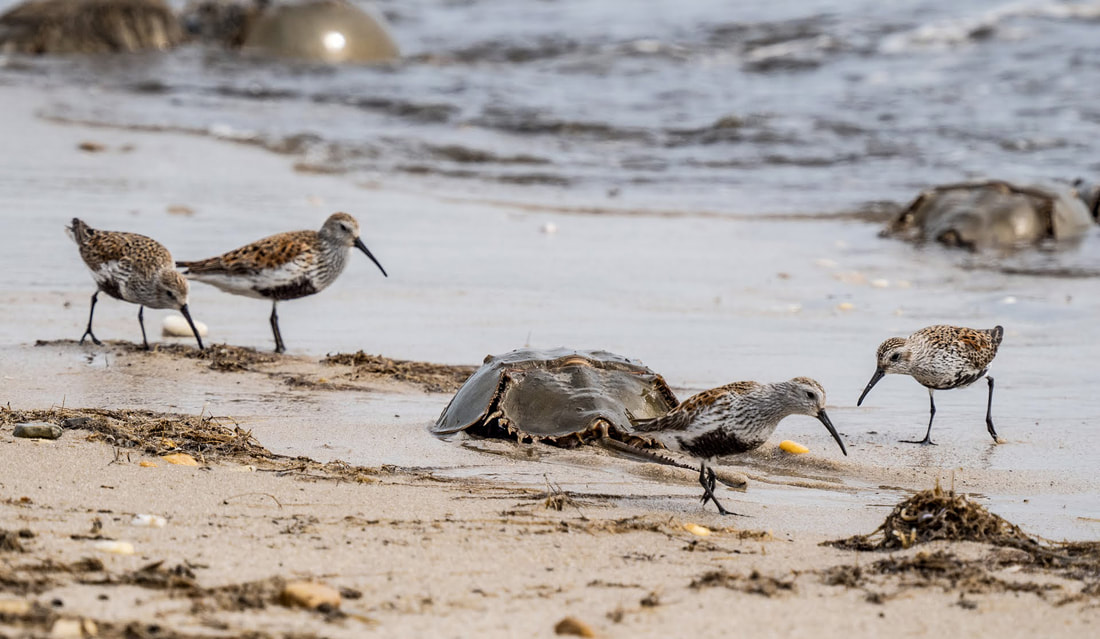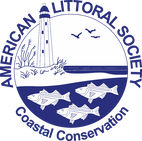|
UPDATE AND ACTION ALERT: Add your voice to ours in opposing the Atlantic States Marine Fisheries Commission (ASMFC) proposal that would endanger Delaware Bay horseshoe crabs and the migratory shorebirds (like the Red Knot) which depend on them. Overharvesting of horseshoe crabs by the bait and biomedical industries has put a severe strain on the ecological connection between horseshoe crabs and shorebirds like the threatened Red Knot. Although the Red Knot population is perilously low, the ASMFC has proposed allowing the harvest of female horseshoe crabs, whose eggs provide the food that fuels the final leg of the birds' journey to Arctic nesting grounds. The next step in the ASMFC decision-making process on changing horseshoe crab harvest controls involves public hearings at agencies from the states along Delaware Bay, including New Jersey and Delaware (details below). Anyone can attend the hearings or submit comments via email or mail. Even though agreed upon conservation targets have not been reached, the Atlantic States Marine Fisheries Commission (ASMFC) is proposing changes to horseshoe crab harvest controls that could have a devastating effect on a threatened shorebird, the Delaware Bay ecosystem, and the economies related to both. The Littoral Society and partners are working to convince the ASMFC not to take a step back on protections for horseshoe crabs. You can help by sending your objections directly to ASMFC (find details below). Horseshoe crabs play a vital role to the Delaware Bay ecosystem, as their eggs provide nourishment for imperiled shorebirds such as the federally threatened Red Knot. Each year, thousands of Red Knots fly over 9,000 miles from Tierra del Fuego at the southern tip of South America to breeding grounds in the Arctic Circle. The Delaware Bay is a major stopover point during this long journey, where the Red Knots feast on horseshoe crab eggs to gain the necessary weight to fly the remainder of the way to the Arctic Circle. The birds and the crabs draw ecotourists from around the world, bringing an estimated $35-50 million in annual revenue to New Jersey. Horseshoe crab eggs and larvae are also a seasonal food item of invertebrates and finfish, while the crabs themselves are an important food source for loggerhead turtles.
The pale blue blood of horseshoe crabs used by the biomedical industry to create tests that ensure the sterility of all manufactured medical equipment, surgical implants, and vaccines. Finally, the crabs are also used as bait for commercial American eel and conch fisheries. These competing interests are managed by the Atlantic States Marine Fisheries Commission (ASMFC). But the net result has been overharvesting of horseshoe crabs by the bait and biomedical industries, which puts a severe strain on the connection between horseshoe crabs and Red Knots. Fewer spawning crabs means fewer eggs and therefore fewer Red Knots. In 1998, the Atlantic States Marine Fisheries Commission (ASMFC) adopted a management plan for the horseshoe crab harvest. Since the 2013 fishing season, the ASMFC has set harvest controls using a framework that links the allowable harvest to the Red Knot stopover population. Each year, the ASMFC has selected the same allowable harvest totals based on this framework, which is 500,000 males and zero females. It was agreed that the prohibition on harvesting female horseshoe crabs would not be lifted until the Delaware Bay region hosts at least 81,900 Red Knots or 11.2 million female horseshoe crabs. Neither of these scenarios has occurred, yet the ASMFC has proposed changes that would result in lifting the prohibition on harvesting female horseshoe crabs, further imperiling the food supply for the remaining Red Knots. This is coming at a time when Red Knot population is far from stable. The average Red Knot count at Tierra del Fuego for 2018-2020 declined more than 75 percent from average counts in the 1980s and 2000. In 2021, only 6,800 Red Knots were counted, which is by far the lowest count since surveys began. “Now is not the time to step back from protecting horseshoe crabs and Red Knots,” said Tim Dillingham, Executive Director. "Even the Commission's outside Peer Review Committee raised concerns about this shift in policy, as well as how well public and stakeholder concerns have been taken into account." In the Peer Review report, the experts advised: “Because the changes would lead to harvest of female horseshoe crabs, which has been restricted since the implementation of the original Adaptive Resource Model (ARM) Framework, the Panel cautions the [Working Group] to fully consider if the new reward function truly represents the values articulated by stakeholders in the 2009 ARM Framework.” ACT NOW: Here's how to join us in urging the ASMFC to reject the proposed harvest change at public meetings and in writing:
Live webinars of the public meetings will be held on Wednesday, Sept. 7 at 6 p.m., with NJ Department of Environmental Protection; and Thursday, Sept. 8 at 6 p.m., with the Delaware Division of Fish and Wildlife. Although the meetings are being conducted by agencies in those states, anyone can attend and comment. Register for a webinar. In order to comment during virtual webinar hearings you will need to use your computer or download the GoToWebinar app for your smart phone. Those joining by phone (audio only) will be limited to listening to the presentation and will not be able to provide input. In those cases, you can send your comments to staff via email, U.S. mail, or fax at any time during the public comment period. To attend the webinar in listen only mode, dial 213.929.4221 and enter access code 667-452-901. Public comment in writing will be accepted until 11:59 PM (EDT) on September 30 and should be sent to Caitlin Starks, Senior FMP Coordinator, at 1050 N. Highland St., Suite 200 A-N, Arlington, Virginia 22201; or at [email protected] (Subject line: Horseshoe Crab Draft Addendum VIII).
BILL SHILLINGFORD
8/23/2022 10:27:34 am
Horseshoe crabs are critical to population of migrating birds and other sea creatures . The population has been declining in Delaware Bay and needs protection... Crabbers who are sucking up these crabs at a high rate have several other options they can use for bait .PLEASE tighten up the regulations for the Horseshoe Crab
American Littoral Society
8/23/2022 11:23:19 am
We agree with you wholeheartedly. Please pass your comment on to the state agencies now in the process of determining whether to change harvest controls in Delaware Bay.
Natalie Maher
8/23/2022 11:44:25 pm
Please commit to protecting the female horseshoe crabs from harvest. The red knots depend on the eggs from the crabs and their partnership must remain intact!!
Georgeann Ventola
8/26/2022 12:03:44 am
Horseshoe crabs are critical to population of migrating birds and other sea creatures . The population has been declining in Delaware Bay and needs protection... Crabbers who are sucking up these crabs at a high rate have several other options they can use for bait .PLEASE tighten up the regulations for the Horseshoe Crab
Stephen Gruber
8/31/2022 11:09:58 am
We are still in that mode of thinking that humans are the most important thing on earth Comments are closed.
|
Archives
July 2024
Categories
All
|


